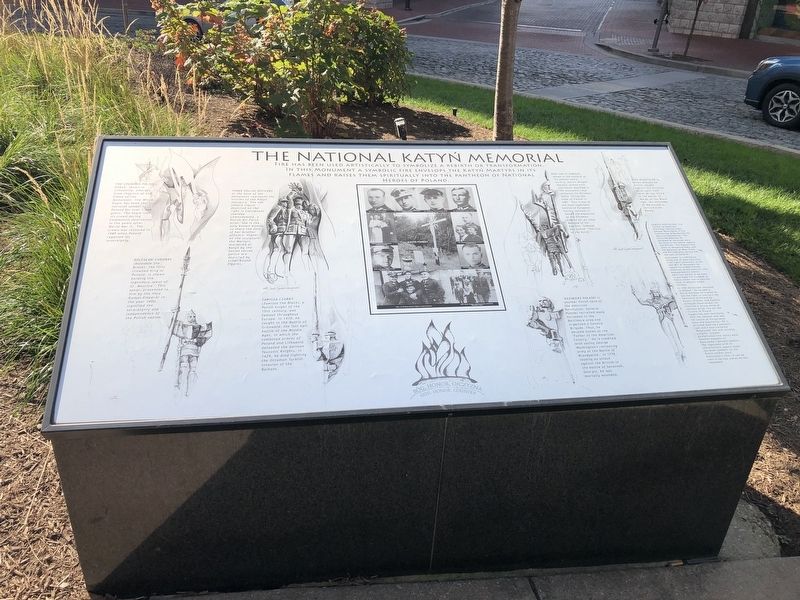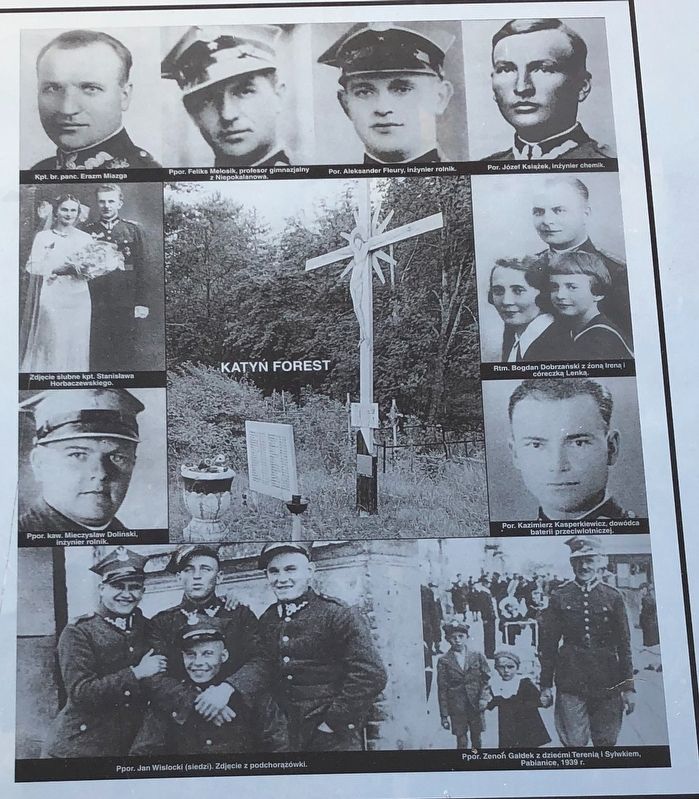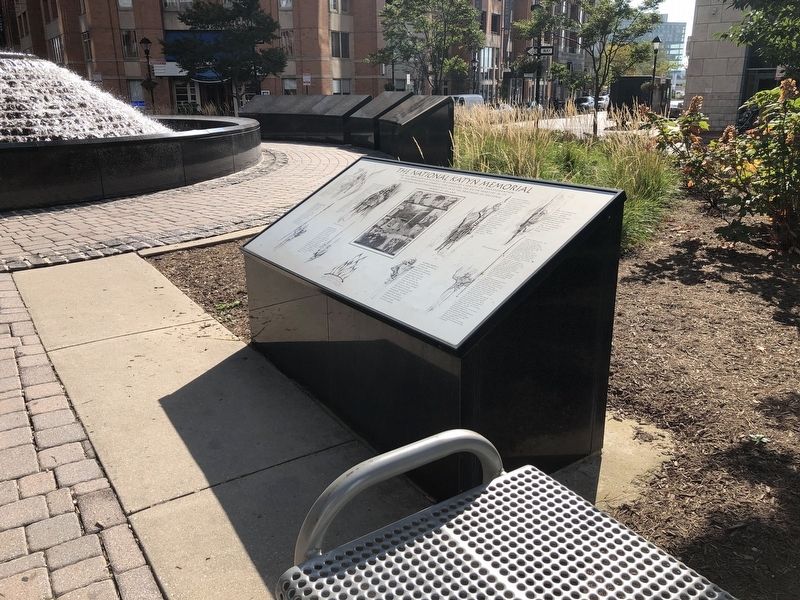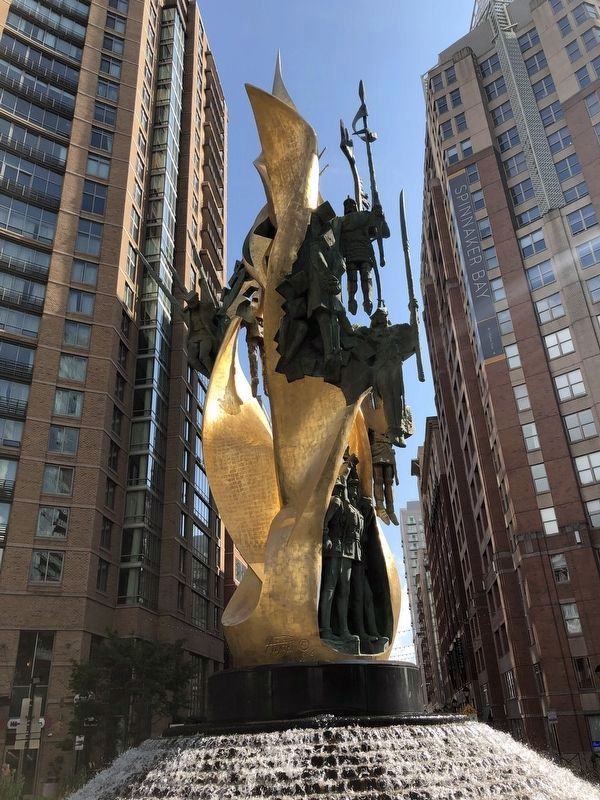Inner Harbor in Baltimore, Maryland — The American Northeast (Mid-Atlantic)
The National Katyń Memorial
Bóg, Honor, Ojczyzna
— God, Honor, Country —
Fire has been used artistically to symbolize a rebirth or transformation in this monument a symbolic fire envelops the Katyń martyrs in its flames and raises them spiritually into the pantheon of national heroes of Poland.
The Crowned Polish Eagle, shown in silhouette, emerges from the core of the flame of the monument. The White Eagle has been the national symbol of Poland for over 1,000 years. The eagle lost its crown during Communist domination in the years after World War II. The crown was restored in 1989 when Poland regained its sovereignty.
Bolesław Chrobry (Bolesław the Brave), the first crowned King of Poland, is shown holding the legendary spear of St. Maurice. This spear, presented to him by the Holy Roman Emperor in the year 1000, signified the sovereignty and independence of the Polish nation.
Three Polish Officers at the base of the monument represent the victims of the Katyń massacre. The one female figure depicted on the right is Lieutenant Jawidga Lewandowska, a Polish Air Force pilot. She is the only known woman to share the fate of her brother officers. Higher on the sculpture, the Martyrs murdered at Katyń by the Soviet secret police are depicted by other bound figures.
Zawisza Czarny (Zawisza the Black), a Polish knight of the 15th century, was famous throughout Europe. In 1410, he fought in the Battle of Grünwald, the last epic battle of the Middle Ages, in which the combined armies of Poland and Lithuania defeated the German Teutonic Knights. In 1429, he died fighting the Ottoman Turkish invasion of the Balkans.
King Jan III Sobieski, shown in the uniform of his famous heavy cavalry, led his Winged Hussars, armed with the lances depicted in the monument, and defeated the Ottoman Turks, lifting the siege of Vienna in 1683. This is one of the most important battles of European history, because it halted the expansion of the Ottoman Empire for all time. Because of his exploits, Sobieski was called "The Lion of the North."
Kazimierz Pułaski is another Polish hero of the American Revolution. General Pułaski recruited in the Baltimore area and organized a Cavalry Brigade. Thus he became known as the "Father of the American Cavalry." He is credited with saving George Washington's retreating army at the Battle of Brandywine. In 1779, leading an attack against the British in the battle of Savannah, Georgia, he was mortally wounded.
King Wladysław III, shown dressed for battle, fought against the Ottoman Turks until 1444 when he was killed in the battle of Warna on the Black Sea. His nickname of Warenczyk is derived from
Tadeusz Kościuszko, the "Father of American Artillery," served under George Washington in the Continental Army during the American Revolution. The fortified defenses he designed at Saratoga were decisive in the battle against the British. His engineering skills in designing these and the defenses at West Point and Philadelphia earned him the Rank of General.
Kościuszko is credited as being one of America's first civil rights advocates. In his Last Will & Testament he named his friend Thomas Jefferson as his executor and bequeathed his entire American estate to purchase the freedom of Negro slaves and to educate them to become useful citizens.
In 1784 Kościuszko returned to Poland. He became a Polish national hero when he led the fight to overturn the Partitions of Poland by Russia, Prussia, and Austria. Although unsuccessful, he instilled a strong sense of national pride into all the citizens of Poland. Supporting and identifying with the common man was the source of his personal fame and popularity. He is pictured wearing a peasant's coat and a four-cornered "Rogatywka" hat and carrying a scythe. Scythes straightened into lances were common weapons of Kościuszko's peasant-soldier. The rogatywka with its characteristic square shape has been symbolic of the Polish soldier since Kościuszko's time. It can be seen
Topics. This historical marker and memorial is listed in these topic lists: African Americans • Civil Rights • Government & Politics • Patriots & Patriotism • War, US Revolutionary • War, World II • Wars, Non-US. A significant historical year for this entry is 1989.
Location. 39° 16.988′ N, 76° 36.108′ W. Marker is in Baltimore, Maryland. It is in the Inner Harbor. Marker is at the intersection of President Street and Aliceanna Street, in the median on President Street. Touch for map. Marker is at or near this postal address: 790 Aliceanna St, Baltimore MD 21202, United States of America. Touch for directions.
Other nearby markers. At least 8 other markers are within walking distance of this marker. The Katyń Massacre, 1940 (within shouting distance of this marker); Katyń Remembered (within shouting distance of this marker); President Street Station (about 300 feet away, measured in a direct line); Baltimore Riot Trail (about 400 feet away); The Inner Harbor Water Wheel (about 500 feet away); Baltimore Public Works Museum (about 700 feet away); Discover Little Italy: A Taste of the Past (about 700 feet away); Rouse-Flick Learning Tower (approx. 0.2 miles away). Touch for a list and map of all markers in Baltimore.
Credits. This page was last revised on October 9, 2021. It was originally submitted on October 9, 2021, by Devry Becker Jones of Washington, District of Columbia. This page has been viewed 229 times since then and 72 times this year. Photos: 1, 2, 3, 4. submitted on October 9, 2021, by Devry Becker Jones of Washington, District of Columbia.



